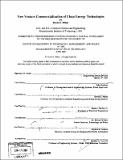New venture commercialization of clean energy technologies
Author(s)
Miller, David S. (David Seth)
DownloadFull printable version (50.75Mb)
Other Contributors
Massachusetts Institute of Technology. Technology, Management, and Policy Program.
Advisor
John Sterman.
Terms of use
Metadata
Show full item recordAbstract
Clean energy technologies lower harmful emissions associated with the generation and use of power (e.g. CO2) and many of these technologies have been shown to be cost effective and to provide significant benefits to adopters. Examples of clean energy technologies include renewable and/or efficient distributed generation (e.g. solar, wind, geothermal, fuel cells, cogeneration); energy efficiency technologies; intelligent energy management; efficient energy storage; green building technologies; biofuels; and ancillary products and services that reduce emissions associated with power generation, transmission and distribution. This thesis examines why new ventures founded to commercialize these technologies have failed to achieve widespread adoption. Based on interviews with clean energy entrepreneurs and other stakeholders and on case studies of clean energy technology ventures, a new venture simulation model was developed that models the cash flow, labor force, market, competition, and product development for a prototypical clean energy technology venture. When the model is parameterized to correspond to a venture that starts with superior technology at an attractive price its behavior corresponds to the experience of many of the companies interviewed. (cont.) The modeled venture takes many years to achieve profitability due to long sales cycles, limits to market growth, and the time needed to gain experience producing and selling its products, and therefore has a high probability of failure. Analysis of the model results in a set of guidelines for what these ventures, investors, and policy makers should do to increase their odds of success. The venture is better off starting with more sales and marketing personnel and expertise rather than engineers, and should develop no more product features than are necessary to sell the product. The venture should forego recurring revenue and instead receive payments up front whenever possible. A single initial equity investment in the venture is considerably more valuable than a series of investments. Government policies that raise the cost of carbon emissions; reduce barriers and increase incentives for adoption of clean energy technologies; and subsidize the development of these technologies can greatly increase the growth of these ventures and the odds of success.
Description
Thesis (Ph. D.)--Massachusetts Institute of Technology, Engineering Systems Division, Technology, Management, and Policy Program, 2007. "June 2007." Includes bibliographical references (p. 245-250).
Date issued
2007Department
Massachusetts Institute of Technology. Engineering Systems Division; Technology and Policy ProgramPublisher
Massachusetts Institute of Technology
Keywords
Technology, Management, and Policy Program.